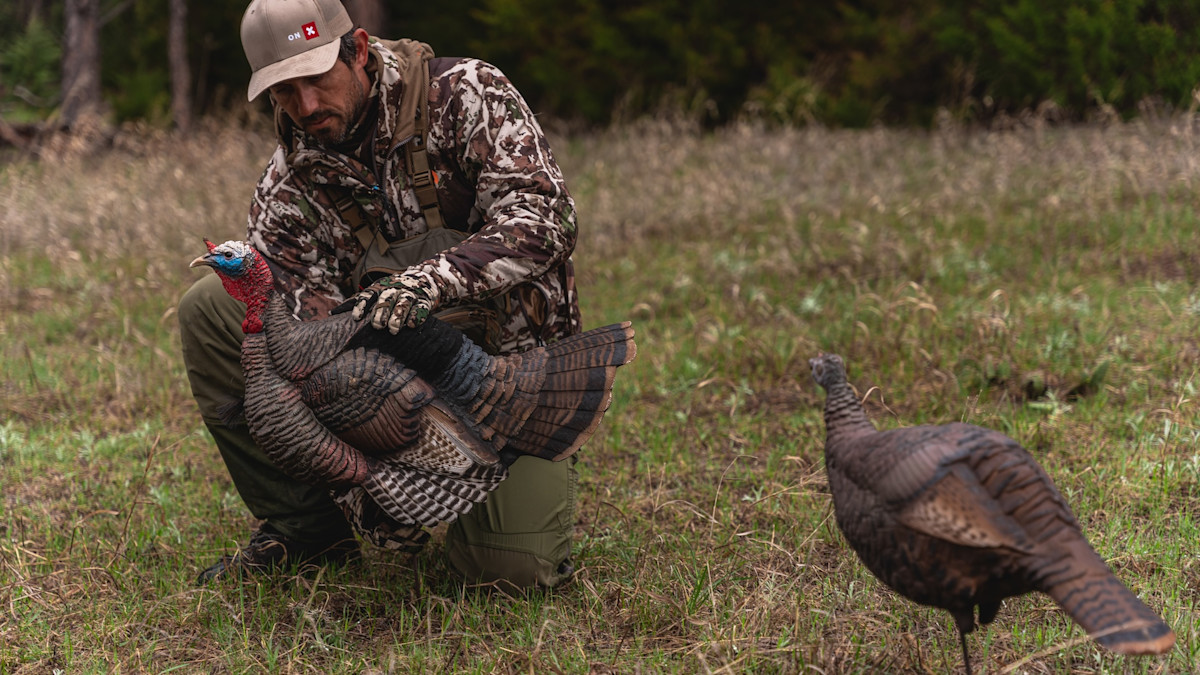
Not long ago, packing an ultra-realistic turkey decoy all but sealed the deal. Stake it out on a field edge, where a tom could see your deke from a county away, and a tom was almost guaranteed to investigate.
When it comes to hunter-educated birds nowadays, it seems to take much more than a realistic decoy or two to coax birds into gun range. While there’s no such thing as a guarantee, aside from Uncle Sam dipping into our hunting budget prior to turkey season kickoff, here are a few decoy tricks to give you an edge this spring.
Add Motion
If you’re fed up with gobbler after gobbler seeing your decoys, hanging up at 100 yards, and losing interest, lack of decoy motion is likely a sizeable part of the equation. Every turkey hunter knows that these birds are constantly on the move; one minute, they’re working your way, and the next, they’re nowhere to be found. With that in mind, it’s easy to assume that a decoy remaining motionless for hours on end has to be a giant red flag to leery birds.
If you’re short on funds and enjoy rigging up contraptions like me, you can make decoy motion stakes with a little ingenuity. The problem becomes, now your setup takes longer to deploy and you have to manually operate that spool of fishing line to make your deke move. This makes aftermarket, battery-powered motion stakes an easy solution.
But if you’re one who likes to keep things simple, the most failproof solution is picking out a turkey decoy that will spin in very little wind. A little side-to-side motion can be the final detail needed to seal the deal. If you’ve already invested a bunch of money into a turkey flock, take a look at your decoy stake and see what you can rig up to make it spin more freely. A crafty modification of your own will get that deke swaying freely in a slight breeze.
Use Real Feathers
Whether you go all in and make your decoy look like a DIY taxidermy project or simply add a real tail fan, something about adding a touch of realism makes decoys that much more effective. It’s likely due to the iridescence that a real turkey feather has that decoy makers will never be able to replicate fully.
Even if your turkey fan of choice looks like a gobbler who lost a fight in a rainstorm, the effectiveness is undeniable. This is where strutter decoys earn their keep. The tradeoff, though, is they’re a pain to pack around and honestly take too long to deploy in many situations.
There are a few tricks to packing around strutters, but it’s always going to be a little clunky. I’ve used pull-behind, three-wheeled golf carts to transport decoys and ground blinds. I’ve also succeeded in lashing decoys to a backpack, frame packs work the best for this method.
In the end, I’ve settled on hand-carrying my strutter decoy and packing the tail fan in a DIY cardboard sandwich strapped to my pack. Jake fans are preferred because they tend to be about two-thirds the size of a mature gobbler fan. Tacking a handle to the bottom of your strutter also seems to make the walk-in a little less cumbersome.
Modify Your Setup
This one is the real deal. Nothing you can do to your decoys will boost your odds of success like perfecting the setup. Entire articles could be written exclusively about mastering the calling setup, so we will focus briefly on each of the components of a good setup.
First, choose a location that turkeys regularly frequent. Even if your setup is only 100 yards away from where the local turkey flock likes to hang out, that can be just enough to discourage a tom from coming in. Next, study the terrain and vegetation to pick out a spot that naturally funnels turkeys into your lap, just like your ideal whitetail funnel. Put this terrain feature between you and the flock.
Now you need to find debris, vegetation, or terrain to hide yourself in. Turkeys can pinpoint your exact calling location, and if they don’t see a turkey in that immediate area but see a camo blob instead, approaching toms will be immediately skeptical.
The ideal placement for your decoy(s) is a place that is visible to approaching gobblers but not visible for too long. A tom that sees your decoy motionless for too long becomes increasingly suspicious. You can usually accomplish this by staking your decoys out in smaller meadows or obscuring your decoy from a wide-open view behind some sparse cover.
Lastly, cater your decoy choice based on seasonality. If it’s early season and the flock has yet to separate, using multiple decoys can add realism. Come later in the season, when the flock has dispersed, a single decoy is what a longbeard expects to find. Like most things, it’s a combination of small details that can tip the scales in your favor—your turkey decoy strategy is no different.
Feature image via Dave Gardner.




